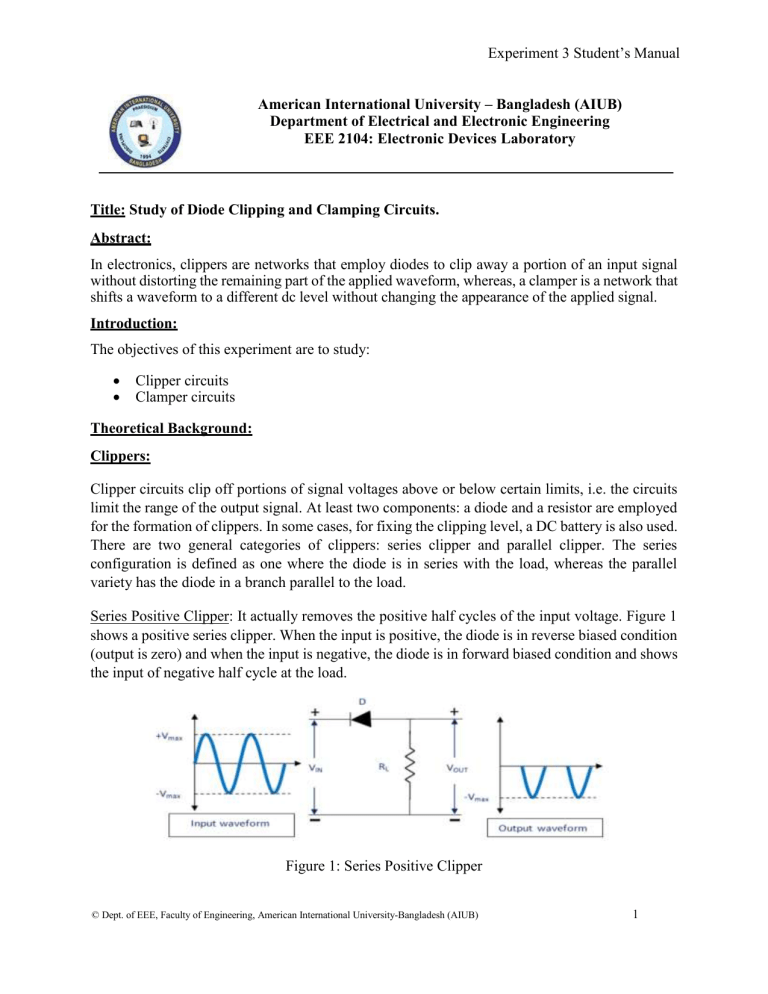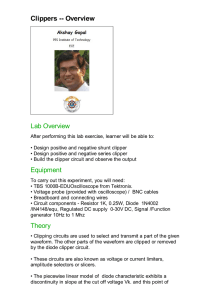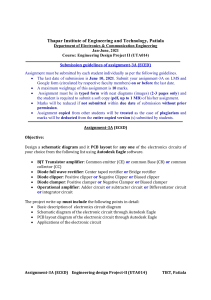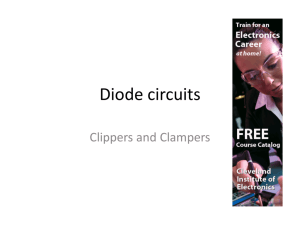
Experiment 3 Student’s Manual American International University – Bangladesh (AIUB) Department of Electrical and Electronic Engineering EEE 2104: Electronic Devices Laboratory Title: Study of Diode Clipping and Clamping Circuits. Abstract: In electronics, clippers are networks that employ diodes to clip away a portion of an input signal without distorting the remaining part of the applied waveform, whereas, a clamper is a network that shifts a waveform to a different dc level without changing the appearance of the applied signal. Introduction: The objectives of this experiment are to study: Clipper circuits Clamper circuits Theoretical Background: Clippers: Clipper circuits clip off portions of signal voltages above or below certain limits, i.e. the circuits limit the range of the output signal. At least two components: a diode and a resistor are employed for the formation of clippers. In some cases, for fixing the clipping level, a DC battery is also used. There are two general categories of clippers: series clipper and parallel clipper. The series configuration is defined as one where the diode is in series with the load, whereas the parallel variety has the diode in a branch parallel to the load. Series Positive Clipper: It actually removes the positive half cycles of the input voltage. Figure 1 shows a positive series clipper. When the input is positive, the diode is in reverse biased condition (output is zero) and when the input is negative, the diode is in forward biased condition and shows the input of negative half cycle at the load. Figure 1: Series Positive Clipper © Dept. of EEE, Faculty of Engineering, American International University-Bangladesh (AIUB) 1 Experiment 3 Student’s Manual Parallel Negative Clipper: It actually removes the negative half cycles of the input voltage. Figure 2 shows a parallel negative clipper. During the positive half of input, the diode gets reverse biased. Thus no current flows through the resistor. As the output current is observed at the load, output signal is achieved for positive half of the input signal. During the negative half of the input signal, the diode gets forward biased and hence no load current is achieved. Ultimately no output is observed for negative half of the input signal. Figure 2: Parallel Negative Clipper The clippers discussed above in figure 1 and 2 are considered as the circuits with ideal diode. But if the knee voltage (VK) is considered (for example, for Si = 0.7 V and for Ge = 0.3 V), the output voltage of positive and negative clippers is shown below. Figure 3: Output of the Circuit of Figure 1 and 2 With the value of VK In some cases, a tiny portion of positive or negative half cycles of the input signal voltage needs to be eliminated. In that case, biased clippers are used. In figure 4, the clipping takes place during the positive cycle only when the input voltage is greater than battery voltage. © Dept. of EEE, Faculty of Engineering, American International University-Bangladesh (AIUB) 2 Experiment 3 Student’s Manual Figure 4: Parallel Positive Clipper with bias Clampers: Clamper circuit adds the DC element which may be positive or negative to the AC input signal. It pushes the signal towards the positive or the negative side as shown in figure 5. Figure 5: Input and Output Wave Shapes of Basic Clamper Circuit The minimum components of a clamping circuit are a capacitor, a resistor and a diode. In some cases, DC supply is applied to give an additional shift. The nature of the waveform remains alike, but the difference is in the shifted level. The peak to peak value of the waveform will never change. The peak value and average value of the input waveform and the clamped output will be different. The time constant of the circuit (RC) must have to be ten times the time-period of the entering (input) AC voltage for better clamping action. A negative clamper is shown figure 6. Throughout the positive half cycle of input, the diode will conduct, and the output voltage will be same as barrier potential of the diode (V0). At that time, the capacitor will get charged to (V - V0). Throughout the negative half cycle of input, the diode will become negative biased, and it has no role on capacitor voltage. The capacitor cannot discharge a lot because of the high value of R. Therefore, output voltage will be - (2V - V0). The peak to peak voltage will be 2V. The output waveform will be the original signal shifted in the downward direction. Figure 6: Negative Clamper Circuit © Dept. of EEE, Faculty of Engineering, American International University-Bangladesh (AIUB) 3 Experiment 3 Student’s Manual Apparatus: 1. Diode (1) 2. Resistors: 1 KΩ (1), 100 Ω (1), 220 Ω (1), 470 Ω (1) 3. Trainer Board (1) 4. Capacitors: 10 µF (1), 0.1 µF (1) Precautions: 5. 6. 7. 8. Multimeter (1) Oscilloscope (1) DC Power Supply (1) Chord (2) The following is a list of some of the special safety precautions that should be taken into consideration when working with diodes: Never remove or insert a diode into a circuit with voltage applied. When testing a diode, ensure that the test voltage does not exceed the diode's maximum allowable voltage. Ensure a replacement diode into a circuit is in the correct direction. Circuit Diagram: (a) (b) (c) (d) Figure 7: Clipper Circuit (a) Figure 8: Clamper Circuit © Dept. of EEE, Faculty of Engineering, American International University-Bangladesh (AIUB) (b) 4 Experiment 3 Student’s Manual Experimental Procedure: 1. Construct the circuits as shown in figure 7. Observe the input and output waves shapes simultaneously on the oscilloscope in dual mode and sketch the waveforms. 2. Construct the circuits as shown in 8 and 9. Follow the procedure as in step 1. Simulation and Measurement: Compare the simulation results with your experimental data/ wave shapes and comment on the differences (if any). Report Questions: 1. How do the waveforms differ from those expected if ideal diodes were used? Why? 2. Discuss how lowering of the load on the clamper circuit affects the output. Discussion: Determine whether or not the theorem was verified. Discuss about the reasons behind the achieved results and practical applications of the theorem based on the experiment. Conclusion: Summarize the experiment here and discuss whether the objectives were fulfilled or not within a short paragraph. Reference: [1] Adel S. Sedra, Kennth C. Smith, Microelectronic Circuits, Saunders College Publishing, 3rd ed., ISBN: 0-03-051648-X, 1991. [2] American International University–Bangladesh (AIUB) Electronic Devices Lab Manual. [3] David J. Comer, Donald T. Comer, Fundamentals of Electronic Circuit Design, John Wiley & Sons Canada, Ltd.; ISBN: 0471410160, 2002. © Dept. of EEE, Faculty of Engineering, American International University-Bangladesh (AIUB) 5






